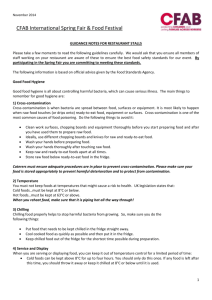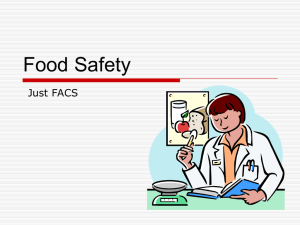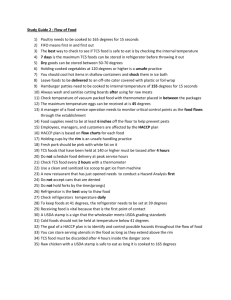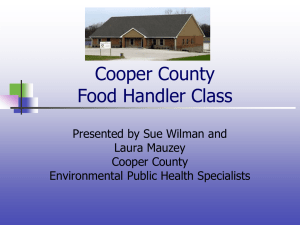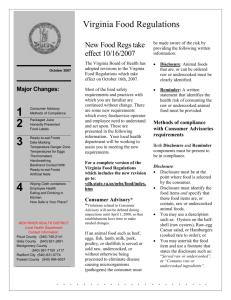CROSS-CONTAMINATION - Health Education Partnership
advertisement
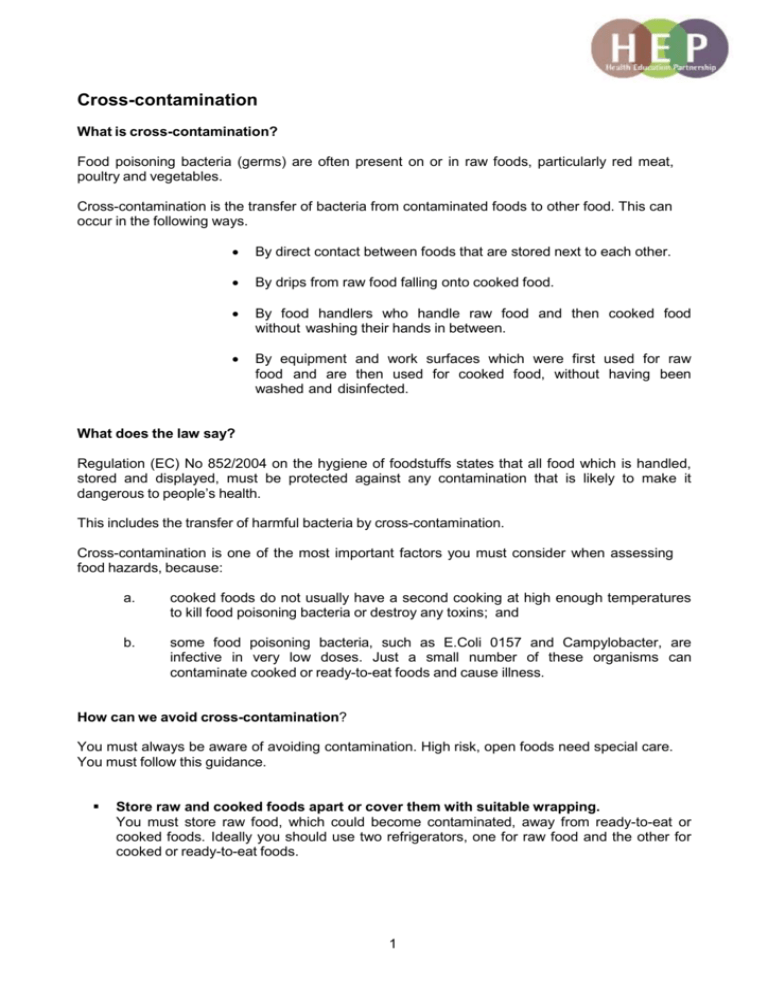
Cross-contamination What is cross-contamination? Food poisoning bacteria (germs) are often present on or in raw foods, particularly red meat, poultry and vegetables. Cross-contamination is the transfer of bacteria from contaminated foods to other food. This can occur in the following ways. By direct contact between foods that are stored next to each other. By drips from raw food falling onto cooked food. By food handlers who handle raw food and then cooked food without washing their hands in between. By equipment and work surfaces which were first used for raw food and are then used for cooked food, without having been washed and disinfected. What does the law say? Regulation (EC) No 852/2004 on the hygiene of foodstuffs states that all food which is handled, stored and displayed, must be protected against any contamination that is likely to make it dangerous to people’s health. This includes the transfer of harmful bacteria by cross-contamination. Cross-contamination is one of the most important factors you must consider when assessing food hazards, because: a. cooked foods do not usually have a second cooking at high enough temperatures to kill food poisoning bacteria or destroy any toxins; and b. some food poisoning bacteria, such as E.Coli 0157 and Campylobacter, are infective in very low doses. Just a small number of these organisms can contaminate cooked or ready-to-eat foods and cause illness. How can we avoid cross-contamination? You must always be aware of avoiding contamination. High risk, open foods need special care. You must follow this guidance. Store raw and cooked foods apart or cover them with suitable wrapping. You must store raw food, which could become contaminated, away from ready-to-eat or cooked foods. Ideally you should use two refrigerators, one for raw food and the other for cooked or ready-to-eat foods. 1 If you must keep both types of food in the same chiller, you must keep them apart and wrapped to prevent cross-contamination. You must keep raw food on shelves below cooked food. Shelves used for raw foods must be cleaned and disinfected before you use them for high risk foods. Keep foods covered, wrapped or in containers to protect them from contamination. Examples include cling film, plastic bags, containers, saucepan lids and net covers. Use separate work surfaces and utensils for raw and cooked foods. Avoid using the same work area, surfaces and equipment if possible. You should use separate equipment and work surfaces for handling raw food and cooked or ready-to-eat food and raw food. We recommend that you use colour-coded equipment which is readily available from most catering equipment suppliers. But systems using colour-coded cutting boards and knives will only work if your staff are trained to use them and understand why colourcoding is being used. To remind staff, it is a good idea to display laminated charts in the work areas showing the relevant colours and their uses. If you can’t provide separate or colour-coded equipment, you must make sure that all equipment is thoroughly washed and disinfected after using it for raw foods. It is important that you check that this cleaning is taking place effectively. Take care with your cleaning and wiping cloths. Cloths can carry bacteria so it is essential that they are clean and changed regularly. Dirty cloths will spread contamination from one area to another and can easily cause cross- contamination. As wiping cloths often remain wet and warm for long periods of time, they can transfer high levels of harmful bacteria. Remember, “a cloth is only as clean as the last thing it was used on.” It is best to use a disposable cloth or paper towels to wipe down work surfaces during food preparation sessions. You must keep any cloths or cleaning equipment clean during use by rinsing them in hot soapy water. If you don’t throw away cloths at the end of the day, you must clean and disinfect them by washing them at a high temperature (boil wash or machine wash at 65oC or above) or by using chemical disinfectants. High standards of personal hygiene. Staff must wash their hands between handling raw food and cooked or ready-to-eat foods. If staff wear gloves, they must remember that if the gloves become contaminated from handling raw food or other sources of contamination, they must change the gloves and wash their hands before putting on new gloves. Care with storage containers. If containers are used at separate times for both raw and cooked or ready-to-eat foods,, cleaning must be effective to destroy food-poisoning bacteria. You must use disinfectants correctly, following the maker’s instructions. 2
